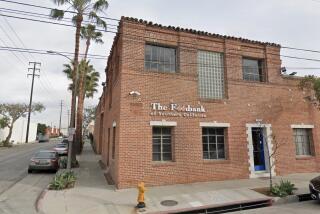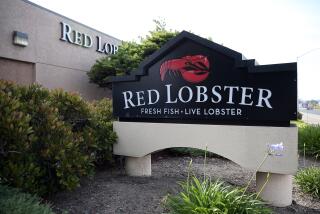Homefed Seized by Regulators : Thrifts: The federal takeover marks the largest S & L failure in U.S. history. Branches will open today and deposits continue to be insured.
San Diego-based Homefed Bank, the nation’s eighth-largest thrift, was seized Monday by federal regulators, making it the largest savings and loan institution to fail in U.S. history.
Homefed, whose capital has been dissipated by a two-year skein of loan losses caused mainly by bad real estate and commercial loans in California and nearby states, was taken over by dozens of officials of the Office of Thrift Supervision at 4:45 p.m.
The institution’s 206 branches will reopen today and depositors’ funds will continue to be insured up to $100,000. “People can go into branches tomorrow and get to their money as usual. There is no effect on checking accounts,” OTS spokeswoman Laurie Lavaroni said.
None of Homefed’s 3,100 employees will be laid off in the foreseeable future, said John Quinn, a spokesman for the Denver office of the Resolution Trust Corp., the agency charged with cleaning up the nation’s thrift mess.
The failure ends a long struggle to salvage the institution, which lost $1.05 billion over the last two years and had long been on the government’s list of troubled thrifts. More than 40% of its holdings consist of troubled assets.
Homefed was unable earlier this year to raise needed capital from private sources to remain solvent. In April, regulators placed Homefed in a special program allowing the thrift to remain under existing management until the government could find a buyer.
The program is designed to reduce the cost of thrift failures. But on June 5, OTS chief Timothy Ryan said that seizures of Homefed and other S&Ls; in the program were imminent after Congress failed to pass funding for the Resolution Trust Corp.
If Congress had voted to provide additional funding to the RTC, there would have been more money available to support a private takeover of Homefed. But it is uncertain whether the government would have been able to put together a deal and avert the seizure that took place Monday. Federal regulators spent the last three months searching for buyers for Homefed, but the slumping real estate market wiped out the viability of many of the properties financed by the thrift. The sheer size of the institution and the vast, complex nature of its loan portfolio apparently were insuperable obstacles to finding buyers.
Quinn, however, said that the unusual timing of the seizure--most regulatory seizures of thrifts have occurred on Fridays--was not caused by any dramatic deterioration in Homefed’s financial condition.
The takeover means that the cost to the taxpayers is likely to be higher than under a private purchase. It will not take longer to dispose of the huge loan portfolio, and the properties are likely to sell at a deep discount because the government already has billions of dollars worth of assets to sell from other failed thrifts.
Quinn said the government has no idea how much it will cost to sell the institution’s branches and assets. Homefed chief executive Thomas Wageman said recently that it would have taken $800 million in private capital to save the institution from a takeover.
With assets of $13.5 billion, Homefed is by far the largest thrift ever taken over by the government. Interestingly, the second- and third-largest failures were also San Diego-based institutions. Imperial Savings with $9.68 billion in assets was taken over in 1989 and Great American Bank with $9.5 billion was seized in 1990.
Along with Great American and Imperial, Homefed was one of three savings and loans in San Diego that were among the leaders of a once-proud industry that virtually financed the California housing boom after World War II.
Formerly known as Home Federal Savings & Loan Assn., Homefed had been in a downward spiral for more than two years as its profits from the 1980s were wiped out by huge write-offs on commercial loans in the early 1990s.
Once the nation’s fifth-largest thrift, the financial institution lost more than $807 million in 1991 after losses of $248 million in 1990. Those losses easily wiped out its profits from 1985 to 1989, when it usually earned more than $100 million a year.
Last month, Homefed Corp., the parent company, held what was to be its last shareholders’ meeting. Company Chairman Kim Fletcher, whose father founded the firm in 1932, apologized for the sorry state of business affairs.
“I’m very sorry for what has happened,” Fletcher said. “. . . This is certainly not the way we planned it.”
Regulators fanned the fires of controversy surrounding Homefed when they gave a fat compensation package to trouble-shooter Wageman to be the new chief executive. In one six-month period, Wageman was paid $1.2 million.
The payments included nearly $860,000 for the sale of his home in Dallas to Homefed. The house sale was a relocation benefit for Wageman as a condition of his taking the Homefed post. But instead of moving to San Diego, Wageman bought another home in Dallas.
At the recent annual meeting, shareholders were sharply critical of Wageman and Fletcher. Noting that loan write-offs under Wageman had virtually wiped out the thrift, one shareholder said: “I think you guys are running around in circles and you’re all crazy.”
Wageman had taken over Homefed from the popular Robert Adelizzi, an industry leader and former Marine who played linebacker at Dartmouth University in the 1950s. Adelizzi was forced out after regulators lost confidence in Homefed’s ability to return to financial health.
Aggressive and growth-oriented, Adelizzi was undone because Homefed made an overabundance of commercial and residential real estate loans on the East Coast. The company also lent heavily to developers in California.
Robert A. Rosenblatt in Washington contributed to this story.
More to Read
Inside the business of entertainment
The Wide Shot brings you news, analysis and insights on everything from streaming wars to production — and what it all means for the future.
You may occasionally receive promotional content from the Los Angeles Times.










